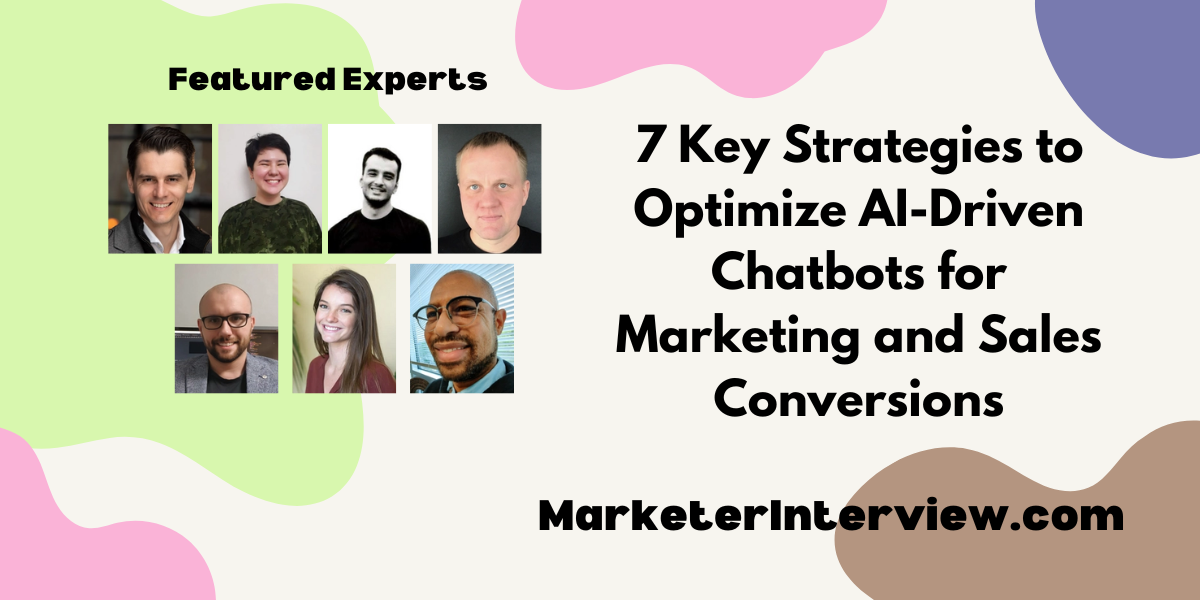7 Key Strategies to Optimize AI-Driven Chatbots for Marketing and Sales Conversions
In the digital age, AI-powered chatbots have become a pivotal tool for boosting marketing and sales conversions. We’ve gathered insights from CMOs and CEOs on how to harness the full potential of chatbots. From incorporating speech-synthesis to implementing a feedback loop, explore the seven transformative strategies these experts recommend.
Want to get quoted in MarketerInterview.com content just like this? Apply to become a contributor today!
Contents
Incorporate Speech-Synthesis in Chatbots
Hello! As an innovator at the intersection of technology and commerce, I’ve seen firsthand how AI can transform business strategies.
Incorporating speech-synthesis technology into chatbots offers another layer of personalization. AI can determine whether a male or female voice, or even the tone and speed of speech, would be more effective in engaging a particular user, based on their interaction history and preferences. This technology not only makes interactions more natural but also more tailored to individual users, thereby increasing the likelihood of conversion. Companies like Google and IBM have been pioneering in this space, with Google’s Duplex and IBM’s Watson Assistant showcasing how nuanced and human-like AI interactions can be.
Moreover, AI-powered chatbots can utilize predictive analytics to anticipate user needs and offer solutions before the user even articulates them. Salesforce’s Einstein AI is a prime example, enabling sales teams to predict customer needs and provide solutions proactively.
Another example is the use of natural language processing (NLP) to understand and respond to user queries more effectively. OpenAI’s GPT-3 has been instrumental in enabling chatbots to understand complex queries and provide more accurate and relevant responses, thereby enhancing user satisfaction and driving conversions.
Lastly, integrating AI chatbots with CRM systems can provide a seamless experience from customer interaction to conversion. HubSpot’s chatbot integrations allow for real-time data exchange between the chatbot and the CRM, enabling personalized interactions based on a comprehensive view of the customer’s history with the company.
In my view, the key to driving more marketing and sales conversions through AI-powered chatbots lies in the depth of personalization and the seamless integration of these technologies into the customer’s journey. By focusing on creating a more personalized and engaging user experience, businesses can significantly enhance the effectiveness of their chatbots in driving conversions.

Ensure Chatbots Facilitate User Contact
People use chatbots to look for information they otherwise would have trouble finding, so make sure you focus on those. Are they looking for a specific service? Do they need to see your expertise in that service before contacting you? Are there any FAQs you can either answer through the chatbot or direct them to? And of course, do not make it hard for them to contact you.
I recently had a terrible experience contacting a service provider for a refund. Not only did they not have the information anywhere on their website, but I also had to rummage through their socials to find their customer service arm. AI chatbots can only go so far—let the users speak to you if they need to!

Veniz Guzman, SEO Expert & Content Strategist, Promet Source
Leverage Hyper-Personalization for Conversion
One way to maximize the effectiveness of AI chatbots to drive conversions and enhance marketing is through hyper-personalization. Seventy-one percent of consumers expect personalized interactions, according to McKinsey & Company. Failing to meet that expectation can lead to frustration, impacting conversions and online reviews.
The AI can analyze past interactions, demographics, and even location data (with customer consent) to tailor responses and recommendations. This personalized approach fosters trust and increases the likelihood of conversion, whether it’s booking an appointment, downloading educational materials, or subscribing to a newsletter.

Lauren Parr, Cofounder and Product Director, RepuGen
Use Chatbots for Interactive Storytelling
One of the more unique ways you can utilize chatbots is by using them as a platform for storytelling and interactive content that educates and entertains your customers while subtly promoting your products or services. This could involve interactive narratives, quizzes, or games that integrate your brand message and offerings.
You can develop a captivating storyline or narrative that aligns with your brand and messaging goals. Consider the interests and preferences of your target audience when creating the storyline to ensure relevance and engagement. Also, incorporate user input and feedback into the story progression to create a personalized experience. Ask your audience questions, prompt them to make choices, or encourage them to provide feedback that influences the storyline or character interactions.
Most people also enjoy interactive elements, so it helps to integrate interactive quizzes, puzzles, or mini-games into the chatbot conversation to break up the narrative and provide that interactive feature for your customers. Offer rewards or unlockable content based on their performance in these interactive elements.

Christian Ofori-Boateng, CEO, ChristianSteven
Deploy Chatbots Across Multiple Channels
Today’s consumers crave personalized attention, and as a result, businesses that prioritize understanding each customer’s needs and providing tailored support see significant traction and growth.
AI-powered chatbots, especially those built on advanced models like ChatGPT, are revolutionizing how companies achieve this. One way businesses can truly leverage this technology is by deploying chatbots across various channels where the brand is present. These chatbots can answer user questions and concerns in real-time, while continuously learning from each interaction to personalize future responses.
Furthermore, we’re also observing that businesses integrating their bots with other tools like CRM, appointment-booking tools, ticketing systems, and mobile apps are able to derive more value. This integration allows them to offer a consistent brand experience across all touchpoints, assisting customers throughout their entire exploration journey.

Yogesh Joshi, Head of Growth, Kommunicate
Analyze and Optimize Chatbot Interactions
My first recommendation would be to continuously analyze and optimize the chatbot’s performance based on user interaction and feedback. Why? Because regularly reviewing data on conversations can help you identify patterns and common questions, but most importantly, find the areas for improvement. The received information can be used to fine-tune the chatbot’s responses, personalize interactions, and tailor marketing messages to better meet the needs and preferences of your customers.
Next, I would recommend integrating your chatbot with a CRM system that can help you track leads, prioritize prospects, and provide more targeted sales recommendations to further increase the chances of conversions.

Tom Molnar, Creative Director, Fit Design
Implement a Chatbot Feedback Loop
I’m Alari Aho, the founder of Toggl. We’re all about making your workday easier with our suite of tools for planning, hiring, and tracking, and I’m always on the lookout for ways to innovate and improve efficiency, including using AI-powered chatbots for marketing and sales. Here’s how you can really make a chatbot work hard for your business.
Implementing a feedback loop from chatbot interactions back into your marketing strategy is a powerful way to enhance effectiveness. Analyze the questions and concerns customers bring up most frequently in chatbot conversations and use this data to refine your marketing messages and product offerings. This continuous improvement cycle ensures that your chatbot not only assists with conversions but also contributes valuable insights for your overall marketing strategy. At Toggl, this approach has enabled us to stay ahead of customer needs and maintain a competitive edge.

Alari Aho, CEO and Founder, Toggl Inc
Want to get quoted in MarketerInterview.com content just like this? Apply to become a contributor today!






